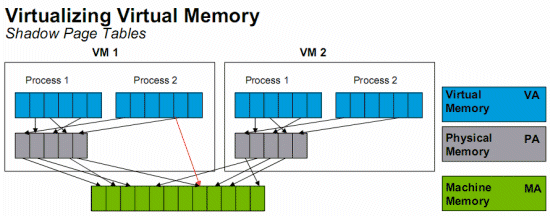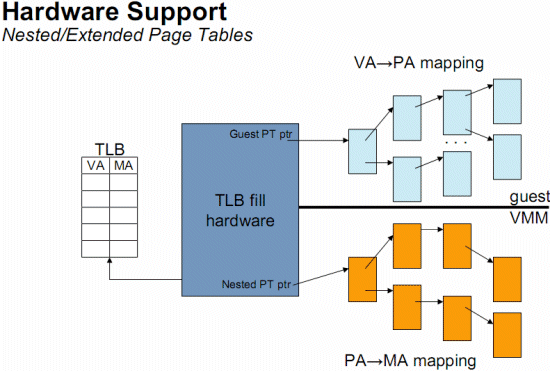Hardware Virtualization: the Nuts and Bolts
by Johan De Gelas on March 17, 2008 3:00 AM EST- Posted in
- IT Computing
The second generation: Intel's EPT and AMD's NPT
As we discussed in "memory management", managing the virtual memory of the different guest OS and translating this into physical pages can be extremely CPU intensive.

Without shadow pages we would have to translate virtual memory (blue) into "guest OS physical memory" (gray) and then translate the latter into the real physical memory (green). Luckily, the "shadow page table" trick avoids the double bookkeeping by making the MMU work with a virtual memory (of the guest OS, blue) to real physical memory (green) page table, effectively skipping the intermediate "guest OS physical memory" step. There is catch though: each update of the guest OS page tables requires some "shadow page table" bookkeeping. This is rather bad for the performance of software-based virtualization solutions (BT and Para) but wreaks havoc on the performance of the early hardware virtualization solutions. The reason is that you get a lot of those ultra heavy VMexit and VMentry calls.
The second generation of hardware virtualization, AMD's nested paging and Intel's EPT technology partly solve this problem by brute hardware force.

EPT or Nested Page Tables is based on a "super" TLB that keeps track of both the Guest OS and the VMM memory management.
As you can see in the picture above, a CPU with hardware support for nested paging caches both the Virtual memory (Guest OS) to Physical memory (Guest OS) as the Physical Memory (Guest OS) to real physical memory transition in the TLB. The TLB has a new VM specific tag, called the Address Space IDentifier (ASID). This allows the TLB to keep track of which TLB entry belongs to which VM. The result is that a VM switch does not flush the TLB. The TLB entries of the different virtual machines all coexist peacefully in the TLB… provided the TLB is big enough of course!
This makes the VMM a lot simpler and completely annihilates the need to update the shadow page tables constantly. If we consider that the Hypervisor has to intervene for each update of the shadow page tables (one per VM running), it is clear that nested paging can seriously improve performance (up to 23% according to AMD). Nested paging is especially important if you have more than one (virtual) CPU per VM. Multiple CPUs have to sync the page tables often, and as a result the shadow page tables have to update a lot more too. The performance penalty of shadow page tables gets worse as you use more (virtual) CPUs per VM. With nested paging, the CPUs simply synchronize TLBs as they would have done in a non-virtualized environment.
There is only one downside: nested paging or EPT makes the virtual to real physical address translation a lot more complex if the TLB does not have the right entry. For each step we take in the blue area, we need to do all the steps in the orange area. Thus, four table searches in the "native situation" have become 16 searches (for each of the four blue steps, four orange steps).
In order to compensate, a CPU needs much larger TLBs than before, and TLB misses are now extremely costly. If a TLB miss happens in a native (non-virtualized) situation, we have to do four searches in the main memory. A TLB miss then results in a performance hit. Now look at the "virtualized OS with nested paging" TLB miss situation: we have to perform 16 (!) searches in tables located in the high latency system RAM. Our performance hit becomes a performance catastrophe! Fortunately, only a few applications will cause a lot of TLB misses if the TLBs are rather large.










2 Comments
View All Comments
toony - Tuesday, March 20, 2012 - link
could you give me a analysis about EPT tech in detail or introduce me some reference about it? thx a lot...RogerAlvarado - Tuesday, August 3, 2021 - link
A deep shows changing for the approval of the phases for the field. The reforms of the https://softwaretested.com/technology/six-ways-sof... are met for the options. The theme is argued for the mid of the final mode for all affairs and activities for the visitors of the posts.